2023 has been an excellent year for TVs, and we’ve had the great privilege of testing several of the best QLED TVs, OLED TVs, and QD-OLED TVs ourselves. That being said, if you’re thinking about upgrading your living room set, strategize on purchasing one as a gift, or simply want to add multiple screens to your home, we’ve put together this list of all the best TVs you can buy right now. These are available in stores and online from popular retailers appreciate Best Buy, Walmart, and Amazon. And considering the time of year, there’s a good chance you’ll be able to score an awesome deal or two on some of our favorite 2023 sets as we eagerly await CES 2024 to see what the TV world will have in store for us next year.
OK, so what’s the best TV you can buy? Well according to our own editor-at-large Caleb Denison, the flagship king of 2023 has got to be the Sony A95L. This QD-OLED has got it all, folks; from amazing brightness levels and ultra-rich colors, to pulse-pounding sound and terrific 4K upscaling. By and large, Sony TVs are usually pretty amazing, but the A95L truly changes the game. Let’s just say it’s going to be tough to beat this model come 2024.
We’re also big fans of all things LG and Samsung, which is why we’ve also featured the LG G3 OLED and Samsung S95C QD-OLED as top picks, too. Do keep in mind that our roundup considers the best TVs for all types of viewers and budgets, but the vast majority of our selections are going to cost upwards of $1,000. After all, these are the very best TVs you’ll be able to find.
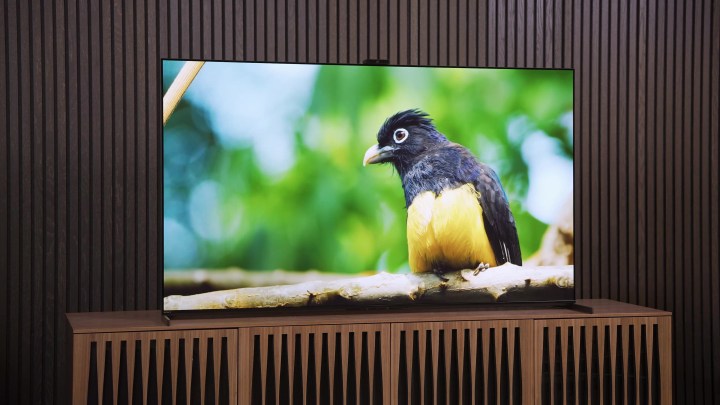
Zeke Jones / Digital Trends
Sony A95L QD-OLED
The best TV you can buy right now
Pros
- Outstanding color accuracy and brightness
- Excellent contrast and luminance
- Great sound
- Gorgeous game mode picture quality
- Incredibly good upscaling
Cons
- Some deep features not available at launch
For those of you familiar with our video content, you’ll know that our own Caleb Denison is quite the discerning TV expert. So when Mr. Denison says that the Sony A95L QD-OLED is the best TV he’s ever reviewed, you know you’re in for some seriously good picture, sound, and other features. And yeah, Sony’s 2023 flagship is a totally killer TV, that just so happens to be equipped with cutting-edge QD-OLED display tech.
For those unaware, “QD-OLED” stands for Quantum Dot-Organic Light Emitting Diode. What we’ve got here is an OLED backbone, complete with a screen that contains self-emissive pixels. But on top of that, there’s also a layer of quantum dots built into the A95L, which does wonders for overall color and peak brightness levels; not to cite the supremely wide color gamut you’ll get to encounter. Those are just the fundamentals though, with Sony giving us plenty more to love about this phenomenal TV.
It’s not too often we get to rave about a TV’s audio system, but we couldn’t believe the type of sound quality the A95L is capable of. With powerful representation in the treble, midrange, and bass sectors, you’d think you were using a great soundbar or surround sound-lite, but nope: it’s all in the TV speakers, friends.
Picture-wise, the list of terrific things to say is nearly endless, but highlights include some of the best color purity and saturation levels we’ve ever seen on a TV, or at least one with these max nit figures. The A95L also delivers some tremendous 4K upscaling, which not only brings lower-res content closer to Ultra HD quality, but also reduces picture noise and other onscreen artifacts to give you final frames that look clean and sharp. The A95L is also a fantastic TV for modern gaming, especially for those of us who own a PlayStation 5 or Xbox Series X/S.
Price-wise, this is going to be one of the most expensive picks on our list, but we really can’t praise the Sony A95L enough. And if you’re on the lookout for a super-great deal on one of last year’s flagship sets, now is the time to track down a Sony A95K.

Sony A95L QD-OLED
The best TV you can buy right now
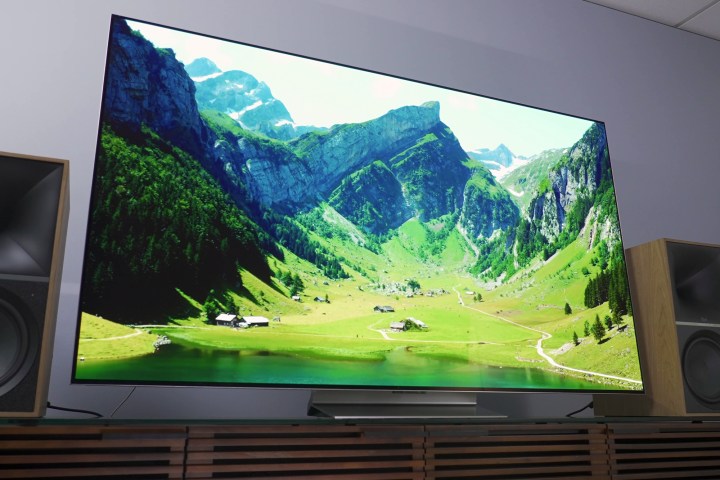
Zeke Jones / Digital Trends
LG G3 OLED Evo
Almost the best
Pros
- Excellent overall brightness
- Dazzling contrast
- Clean, sharp images
- Good motion handling
- Excellent for gamers
Cons
- Disappointing sound
- Frustratingly cluttered UI
With Samsung and Sony’s QD-OLED TVs from last year stealing some of OLED’s thunder for their ability to hit on both the perfect blacks that OLED is known for and the high brightness and pure colors of QLED, it left many TV aficionados wondering how OLED would reply. The 2023 LG G3 OLED is that response, and as Denison says in his review: “Wow. Just … wow.” Denison was also thoroughly blown away by the equally impressive Samsung S95C QD-OLED that we’ll get into more below, but here we’ll also point out some of the differences between our two top picks.
The first of LG’s TVs in the U.S. to brandish LG’s new micro-lens display (MLA) and “Brightness Booster Max” technology, LGs new OLED panels deliver better brightness, better viewing angles, and better energy efficiency than their previous TVs, with the LG G3 pumping out between 1,450 and 1,520 peak nits in our testing. In short: you no longer need to look to QLED or QD-OLED (appreciate the Samsung S95C) if maximum brightness is a key buying point for a new TV. That, and you also get those perfect, deep black levels that LG’s OLED panels are famous for — now it doesn’t matter whether you put this TV in a dark basement living room or a sun-soaked main floor family room.
appreciate its predecessor, the LG G3 comes in 55-, 65-, 75-, and 83-inch models and, as part of LGs Gallery Series, is meant to be wall mounted — it even comes with a no-gap wall mount, something the Samsung S95C does not. Connection options include four HDMI 2.1 ports, an eARC port, Wi-Fi 6E, an Ethernet connection, and Bluetooth 5, and the LG G3 has uphold for HDR10, HLG, Dolby Atmos sound, and, most importantly, Dolby Vision, which I’ve left to the end to point out that it could be the one sticking point over the S95C as Samsung still does not uphold Dolby Vision.
Denison’s review also predicts that gamers in particular are going to be into the LG G3’s extra brightness, but also its 120Hz refresh rate, NVIDIA G-Sync compatibility, AMD FreeSync Premium, and VRR specs, which will translate into some super-smooth gaming experiences.
We’ll leave off with Denison’s final thoughts on the G3: “Top to bottom, the LG G3 is an absolute star of a TV. It’s a delight. It’s exciting. It’s luxurious. It is everything a super-premium TV should be.”

LG G3 OLED Evo
Almost the best
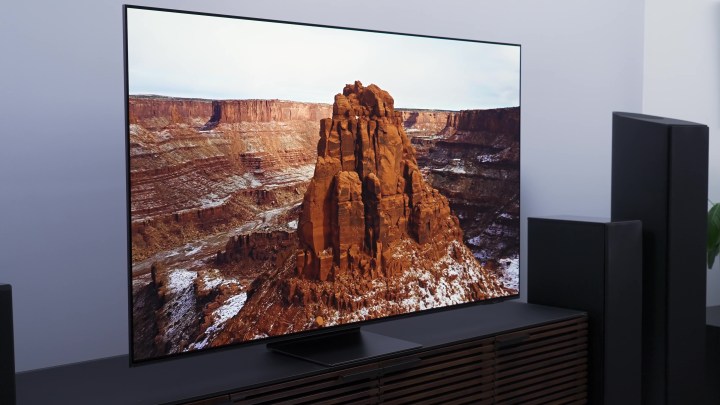
Zeke Jones/Digital Trends / Digital Trends
Samsung S95C OLED
Ties with the LG G3
Pros
- Incredibly bright colors
- Perfect black levels
- Pristine overall picture
- Great upscaling
- Awesome for gaming
Cons
- Mediocre sound
- No Dolby Vision uphold
For 2023, Samsung has pushed forward with its stellar flagship quantum dot OLED TV, moving the S95B up the alphabet to its next-generation, the off-the-charts S95C. As we mentioned in our intro, after reviews of the LG G3 and Samsung S95C, both TVs are so good that flipping a coin would be the best way to select. But let’s get into the Samsung S95C.
First off, the S95C is every bit as good as the S95B (which is still on our list below), but improves on it with better brightness, sleeker design, and better features. In fact, Denison calls the S95C “the best TV Samsung has ever made.” Although it doesn’t come with a wall mount appreciate the LG G3, the all-metal stand mount is sturdy, stable, and leaves enough space for a soundbar underneath, but more importantly, it cradles the S95C’s One Connect box that was once only found with Samsung’s 8K QLED TVs. One of the main differentiators from the LG G3, the One Connect box is a rather ingenious solution for messy and awkward cables at the back of your TV as it puts all those connections in a separate sleek box that connects to the TV with one cable.
As you might expect, picture quality is off the charts. Starting with brightness, the S95C is 60% brighter than its predecessor, peaking at 1,600 nits in our own tests. And that’s bananas. True to QLED and QD-OLED panels, this TV will be more than fine in any bright room you want to put it in. Color brightness is also very good and accurate on this TV, with 100% of P3 color space, and 75% of BT.2020, and Denison praised it for having a “super vivid vibe that, when combined with OLED’s perfect blacks, is simply unmatched by any other TV technology.” However, there is that matter of Samsung still not supporting Dolby Vision, the dynamic HDR format that’s supported by several streaming services. If that’s a deal breaker for you, and it shouldn’t be, then scroll back up to the LG G3.
Gamers will be delighted by the S95s Game Mode that supports fast gaming at up to 120Hz, and because it’s a Samsung, gamers can also tap into Samsung Gaming Hub for cloud gaming without the console.
One of the other differentiators between the S95C and the LG G3 is the Samsung’s array of eight bass transducers on the back of the TV, which, Denison reports, don’t really add much to the native sound of the set and you’d still be better off getting a soundbar. Speaking of sound, the S95C does uphold Dolby Atmos sound, as well as pass through via eARC, but not DTS passthrough, sadly.
Available in 55, 65, and 75-inch models ranging from $2,500 to $4,500, this TV and the LG G3, are going to be hard TVs to beat.

Samsung S95C OLED
Ties with the LG G3

Zeke Jones / Digital Trends
LG 77-inch M3 Wireless OLED
Premium picture meets cutting-edge tech
Pros
- Gorgeous OLED picture quality
- Low-latency wireless for gaming
- Solid wireless signal connection
- Easy setup
- Good sound
Cons
- Wireless box needs true line of sight
The LG M3 Wireless OLED has arrived to overcome a problem that a lot of home theaters struggle with: having too many wires to run. When it comes to power cables, we’ll always be reliant on a guide and power brick (at least for the foreseeable future), but as far as AV connections go (HDMI and digital optical), this is where TVs appreciate the LG M3 are starting to change the game. In terms of picture quality, the M3 is pretty much toe-to-toe with the amazing LG G3, our favorite OLED this year. But the true calling card feature is the M3’s ability to wirelessly acquire picture and sound from a broadcasting unit called the Zero Connect Box.
The Zero Connect includes three HDMI ports that can push 4K at up to 120Hz (and the second port is eARC/ARC compatible), digital optical, ethernet, two USB-A, and an output for an IR blaster. And as long as the transmitting device is in range of the M3 TV’s receiver, you’ll be able to relish wireless audio and video. Do keep in mind that if you’re planning on using a soundbar, you’ll want to have the Zero Connect located fairly close to the TV, otherwise, you probably won’t have enough cord length to place the soundbar under the M3.
As mentioned, the picture quality on this model is right on par with the LG G3, and when we tested the M3 ourselves, we experienced zero troubles with latency or any kind of compression or pixelation. This is definitely the kind of next-gen TV that leans on one awesome feature more than any other, and at $5,000 we do wish the Zero Connect box was a little smaller and completely reliable in the signal-range department. But if you told us a year ago that we’d have the ability to go wireless with our HDMI gear, and the picture and sound would be just as good as running physical cables, we’d scoff and laugh. But the LG M3 Wireless OLED has proved us wrong.

LG 77-inch M3 Wireless OLED
Premium picture meets cutting-edge tech
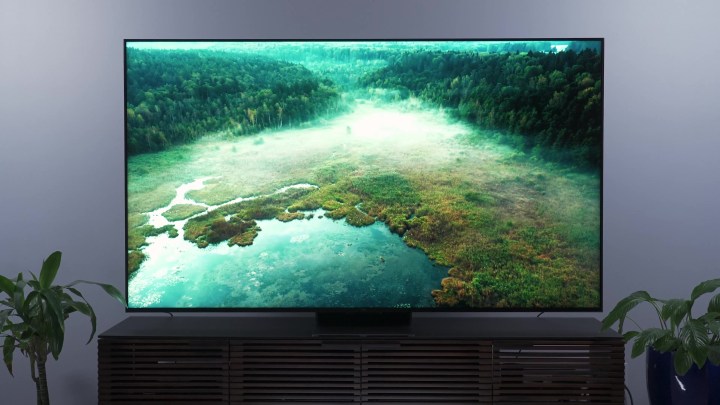
Zeke Jones/Digital Trends
TCL QM8 mini-LED
The TV most people should buy
Pros
- Stunning HDR performance
- Class-leading brightness
- Excellent black levels
- Virtually no detectable blooming
- Very good color saturation/brightness
Sure, the LG G2 and Samsung S95C are the cream of the crop this year so far, but around $3,000 for either of those 65-inch panels can be a jagged pill to swallow. And even if you consider that the latest step-down 65-inch LG C3 OLED is still north of $2,000, may we present to you a TCL TV that has closed the performance-versus-price gap so thoroughly, that it surprised us: the 2023 TCL QM8.
With appeal to an extremely broad audience, the TCL QM8 sits at the top of TCL’s new Q class flagship lineup with this 4K mini-LED QLED TV that runs Google TV. As we mentioned in the intro, 2023 has so far been all about brightness, something that TCL promises with the QM8 with its “High Brightness ULTRA LED Backlight” technology. So … it’s bright then?
You betcha. In fact, in our review of the QM8, Caleb Denison’s calibration tool is only rated to accurately read up to 2,000 nits of brightness, which is already insanely powerful. The QM8 blew past that, giving readings of up to 3,500 nits in HDR mode before some tweaking settled things to a more consistent 2,500 (TCL’s website lists the peak nits at 2,000 though). The TL;DR here is: schnikies, it’s bright.
But how about the black levels? While deep inky blacks is the calling card of OLED technology, this mini-LED gets really close, with excellent contrast and uphold for Dolby Vision IQ, HDR10+, HDR10, and HLG. Denison was impressed, stating: “The contrast on this TV is just out-of-this-world impressive, partially because it can get so bright, yes, but also because its blacks are remarkably good.” The brightness and black level capabilities make this a great choice for both dark home theater dens and bright rooms.
Color-wise, the TCL QM8 is great, too, covering 97% of DCI-P3 and about 76% of BT.2020 color gamuts, and the TV looks excellent out of the box even without calibration. And while Denison did see some motion judder when viewing some higher-quality shows, there’s a de-judder option in the settings that can nip that in the bud. But gamers will be pleased with the QM8’s uphold for VRR, and there’s an auto game mode with AMD FreeSync Premium Pro.
The TCL QM8 is available in 65-, 75-, 85-, and 98-inch variants ranging in price from $1,200 to $10,000.

TCL QM8 mini-LED
The TV most people should buy
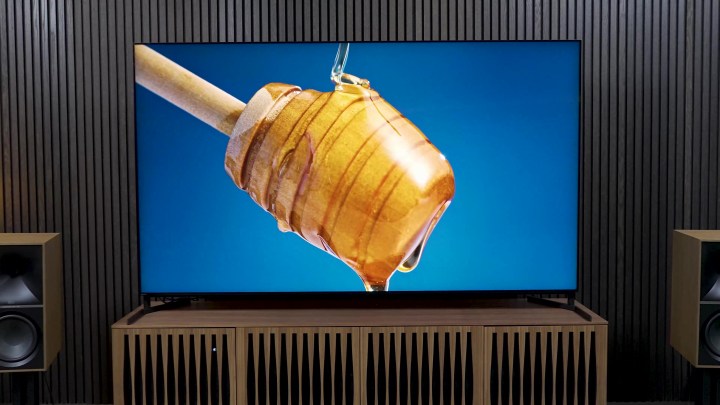
Zeke Jones / Digital Trends
Sony XR X95L mini-LED
One of the brightest mini-LEDs
Pros
- Brilliant contrast
- Excellent color accuracy
- Smooth motion
- Minimal blooming and halo
- Excellent gaming features/picture quality
Cons
- Quirks with picture quality with some streaming apps
Sony has plenty of representation in this best TV roundup, but there was no way we were going to pass up the amazing Sony XR X95L mini-LED set. Now, side by side with the also-quite- amazing Sony XR X93L (which is our next featured pick), the X95L really isn’t too different. What really separates both models is not much more than local dimming capabilities and brightness levels, but if you’re a nose-to-the-screen videophile with grand expectations, the X95L is probably the set to go with.
Over the last couple of years, we’ve seen mini-LED lighting implemented on more and more TVs, and the results never get old. But what starts to grind our gears is picture maladies appreciate haloing and light bloom. Unless you’re dealing with an OLED set, you’re pretty much always going to have to contend with some level of blooming on an LED-driven set, and the X95L is no exception. However, what you’ll get with this Sony flagship is the most minimal amount of haloing and bloom there could possibly be.
Thanks to features appreciate XR Backlight Master Drive and XR Triluminos Pro, the X95L’s picture performance is fine-tuned within an inch of its life, delivering some of the brightest and boldest picture quality we’ve ever seen. And whether you’re watching 4K HDR content, or something relatively low-res, the X95L is going to ensure that your source is as visually rich as possible. That’s on top of features appreciate HDMI 2.1, an immersive gaming dashboard for PS5 and Xbox optimizations, as well as one of our favorite smart TV platforms, Google TV.
As of right now, the only X95L size that seems to be available is the 85-inch model. When quantities better, you should also be able to grab this set in 65 and 75-inch sizes, but there was no way we were going to miss the opportunity to dish about it. For now though, if you’re looking for some slightly smaller big-screen options, the Sony XR X93L is just as good as the X95L, save for those extra local dimming zones and higher nit numbers.

Sony XR X95L mini-LED
One of the brightest mini-LEDs

Zeke Jones/Digital Trends
Sony XR X93L mini-LED
Premium performance without the Sony tax
Pros
- Excellent motion resolution
- Stellar color accuracy
- Bright, punchy HDR performance
- Solid black levels
Cons
- Some backlight blooming/halo
- Poor off-angle performance
Depending on how nerdy you are in the TV space, you may or may not notice that Sony’s 2023 X93L mini-LED TV looks exactly the same as last year’s flagship mini-LED, the X95K. Well, actually, apart from what Sony says is some software improvements, it is exactly the same. And that’s not a bad thing, because the X95K was (and still is) an excellently bright, colorful, and contrast-capable TV backed by Sony’s powerful Cognitive Processor XR. So what’s the fuss, then? Sony’s TVs tend to go for a premium (don’t get us started on the “Sony tax”), so the big takeaway here is that the X93L is a great way for you to get in on all the premium performance of the X95K and save your wallet in the process.
For a comparison, the 65-inch X95K was $2,800 at launch. The 65-inch X93L was $2,200 at launch. Boom, you just saved $600 for a sweet TV. But let’s talk specs, shall we? In our review, Caleb Denison’s assessment of the X93L’s picture performance out of the box was “excellent,” with how brightness tests revealing an impressive peak of 1,800 nits. Color and contrast are killer, too, and the TV supports HDR10, HLG, and Dolby Vision. There are also some presets for movie lovers in the form of an IMAX Enhanced mode and a Netflix calibrated mode, too.
Denison praised the X93L’s “stellar motion processing and low-resolution content upscaling, excellent tone-mapping, and color accuracy,” all calling-cards of Sony. And all that new software stuff we mentioned includes a new Eco Dashboard for managing eco settings, some additional black level adjustments for seeing darker scenes better, and a new gaming dashboard that lets you toggle VRR on and off between 60Hz and 120Hz, which gamers will rejoice over.
One of the only downfalls Denison could find with the X93L is the inclusion of only two HDMI 2.1 inputs, whereas most new TVs have four. Available in 65, 75, and 85-inch models, Sony’s new mini-LED ranges on price from $2,200 to $4,400.

Sony XR X93L mini-LED
Premium performance without the Sony tax

Zeke Jones / Digital Trends
Sony 65-inch X90L LED
Best value Sony LCD TV
Pros
- Punchy HDR performance
- Oustanding color and grayscale accuracy
- Excellent motion handling
- Solid value
Cons
- Minimal blooming/halo
- Unimpressive sound
When it comes to mid-tier TVs, Sony is a little quieter these days than it used to be. But that doesn’t mean the Bravia stalwart is only focusing on flagship sets, because the 2023 X90L is hard proof that Sony always means business, even at lower prices. What we’ve got here is a bold and brilliant full-array LED set that delivers exceptional HDR performance, next-level gaming specs, and the algorithmic king of smart TV platforms, Google TV. Available in 55-, 65-, 75-, 85-, and 98-inch sizes, whatever viewing space you’re working with, there’s an X90L to match the room.
Our own editor-at-large Caleb Denison took a hard look at the Sony X90L, and was more than prepared to start issuing demerits for the TV’s relative lack of dimming zones when compared to the TCL QM8 and Hisense U8K. There’s also the fact that both of the latter are equipped with mini-LED lighting systems, which basically guarantees excellent brightness and colors with minimal light blooming. But even though the Sony X90L uses a less advanced LED setup, the TV still delivers a phenomenal picture. In fact, when it comes to color accuracy, our X90L assess results came out on top (with the TCL QM8 and Hisense U8K trailing after).
Now in terms of light blooming and haloing, we’re not totally in the clear. In our testing of the X90L, we noted a bit of both image maladies when viewing certain content; and when it comes to the X90L’s sound, you should definitely be thinking about a soundbar to go with your new TV purchase (re: not great). But these are small grievances that are easy to forgive when observing the bigger picture (TV pun intended). The Sony X90L isn’t a perfect LED TV, but it does an admirable job at handling everything from HDR films to high frame-rate PS5 gaming, and it’s a pretty good price.

Sony 65-inch X90L LED
Best value Sony LCD TV
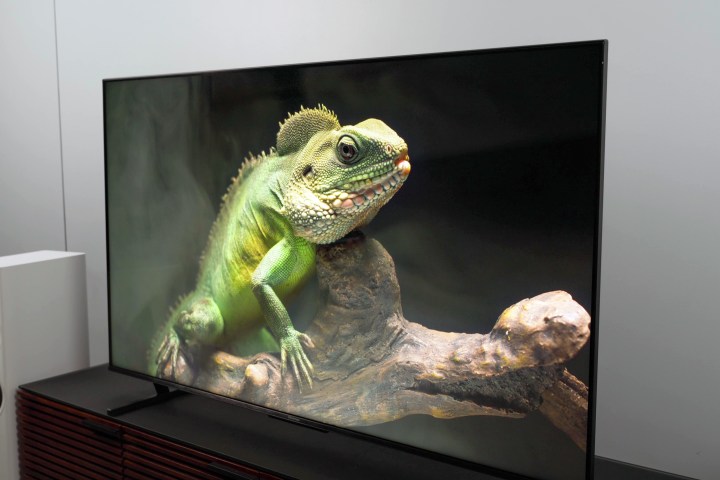
Image used with permission by copyright holder
Hisense 65-inch U8K
One of our favorite budget-friendly sets
Pros
- Excellent brightness
- Vivid HDR colors
- Very good backlight control
- Excellent contrast
- Great for gaming
Cons
- Some color anomalies
- Scattered software bugs
Ah yes, the Hisense U8K ULED. For those unaware, Hisense used to be the budget-friendly brand displayed on a single end cap at Best Buy. You’d say “what is Hisense?”, watch the little demo video on the TV, and walk away. Nowadays, big box stores have entire display walls dedicated to one of the world’s reigning LED and QLED (well, Hisense calls it “ULED”) champs, and the amazing U8K ULED is one of our favorite TVs for 2023, bar-none. Why, you may ask? It can get super-bright without disturbing color accuracy, its HDR performance is excellent (for the price), and the black levels are some of the best we’ve seen for a 2023 mid-tier set.
Motion handling is pretty solid on this guy, too; and when it comes time to stream some Better Call Saul and Barry on Max, Google TV is the captain of this smart TV ship. Not only will you have access to all kinds of apps, Google Assistant, and Chromecast, but Google will takes your viewing choices and populates your Home Screen with recommended movies and shows based on what you love to watch.
As for upscaling, we’re impressed by what the U8K can deliver, especially when it comes to color gradient processing. In non-tech terms, when you’re watching broadcast cable or even a YouTube video, even if the source claims you’re receiving a full 4K signal, you’re still dealing with a good amount of compression and signal distortion (especially with cable TV). That means it’s up to your TV to use all of its onboard enhancement tools to give you the best final picture possible, regardless of whatever interference you’re dealing with. And if you ask us, the Hisense U8K pulls this off better than most of its competition.

Hisense 65-inch U8K
One of our favorite budget-friendly sets

Zeke Jones / Digital Trends
Samsung 65-inch QN90C
A killer Samsung QLED
Pros
- Class-leading HDR performance
- Excellent black levels, backlight control
- Outstanding color performance
- Powerful processing
- Premium design and build
Cons
- Frustrating Smart TV OS
- Lofty price
The Samsung QN90C is a stunning 4K TV, and if you’re looking to get a premium set without dipping your toes into the $3,000-plus flagship pool, Samsung’s latest Neo QLED dazzles for more reasons than one. For starters, it’s hard to beat the kind of punchy HDR performance you’ll get here. Without having to dial in ultra-bright picture settings, we found that the QN90C delivered incredible peak brightness levels when using filmmaker mode. Now although the real peak brightness laurels (the QN90C peaks at around 2,000 nits for SDR and HDR viewing) are reserved for this year’s amazing Samsung S95C, the QN90C is no straggler. In fact, when compared to TCL’s QM8 and Hisense’s U8K, this Samsung has the better overall picture quality.
In our testing of the QN90C, we used a number of low-resolution and low bit-depth content to see just how efficiently the TV could handle 4K upscaling (which is no easy feat). Compared to the aforementioned TCL QM8 and Hisense U8K, we found that the QN90C was better at reducing color banding, pixelization, and posterization; so if you’re looking for the kind of TV that can improve whatever low quality streams or super-old DVDs you’re tossing at it, the QN90C more than delivers. We’re also glad to report that you’ll have your pick of four full-bandwidth HDMI 2.1 inputs, each of which supports refresh rates up to 144Hz.
And if you’re really on the fence about this Neo QLED, we’ll happily push you over with some other good news: Samsung’s switchover to ADS panels proved to be a solid proceed for off-angle viewing, and thanks to mini-LED backlighting, the black levels on this bad boy are awesome, too. Sure, it may not be on par with an LG OLED (or the S95C), but the QN90C still screams “premium,” but without getting into absolutely-need-to-finance-this territory.

Samsung 65-inch QN90C
A killer Samsung QLED
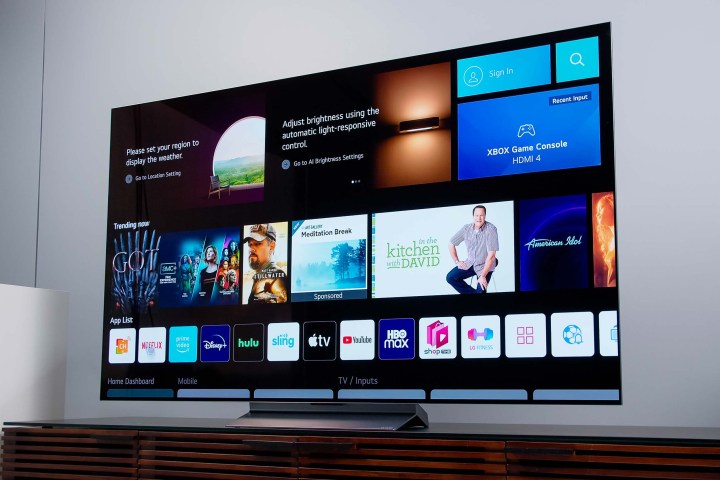
Dan Baker/Digital Trends / Digital Trends
LG C2 Evo OLED
Another great LG OLED
Pros
- Slick new design
- Improved peak brightness
- Excellent black levels
- Solid color accuracy and gamut
- Great for gamers
Cons
- Some peak brightness artifacts
- Complex smart TV system
When LG rolled out its new OLED Evo panels on a handful of 2021 models, we were beyond impressed with what the new hardware meant for TV-watching, especially certain types of movies. With promises of OLED-flavored contrast linking hands with the type of brightness only seen on the most powerful QLED sets, the Evo engineering delivered an all-immersive, at-home cinema encounter that looks fantastic in even the most brightly-lit rooms.
2022 brought us the much-loved LG C2 OLED Evo. While not considered a flagship set, the C2 builds upon a number of the amazing picture features and other add-ons that we loved about its predecessor, the LG C1.
Available in sizes from 55 inches up to 83 inches, the 65-inch C2 is the perfect middle-ground size for most homes. And in terms of design and tech, LG really notched things up last. The C2 features a totally reworked WRGB screen with chart-topping peak brightness marks, four HDMI 2.1 inputs for all our next-gen entertainment sources, and an improved Alpha 9 Gen 5 processor that delivers breathtaking colors, adaptive brightness control, and incredible upscaling.
Gamers will appreciate the inclusion of Nvidia G-Sync and AMD FreeSync, with both technologies banding together to create the ideal TV for high-bandwidth, action-oriented gameplay from today’s leading consoles and PCs.
While the sound isn’t something we’d sing the praises of, LG made good on its promise of a revamped and reimagined C series TV, and we couldn’t suggest the LG C2 OLED Evo more.
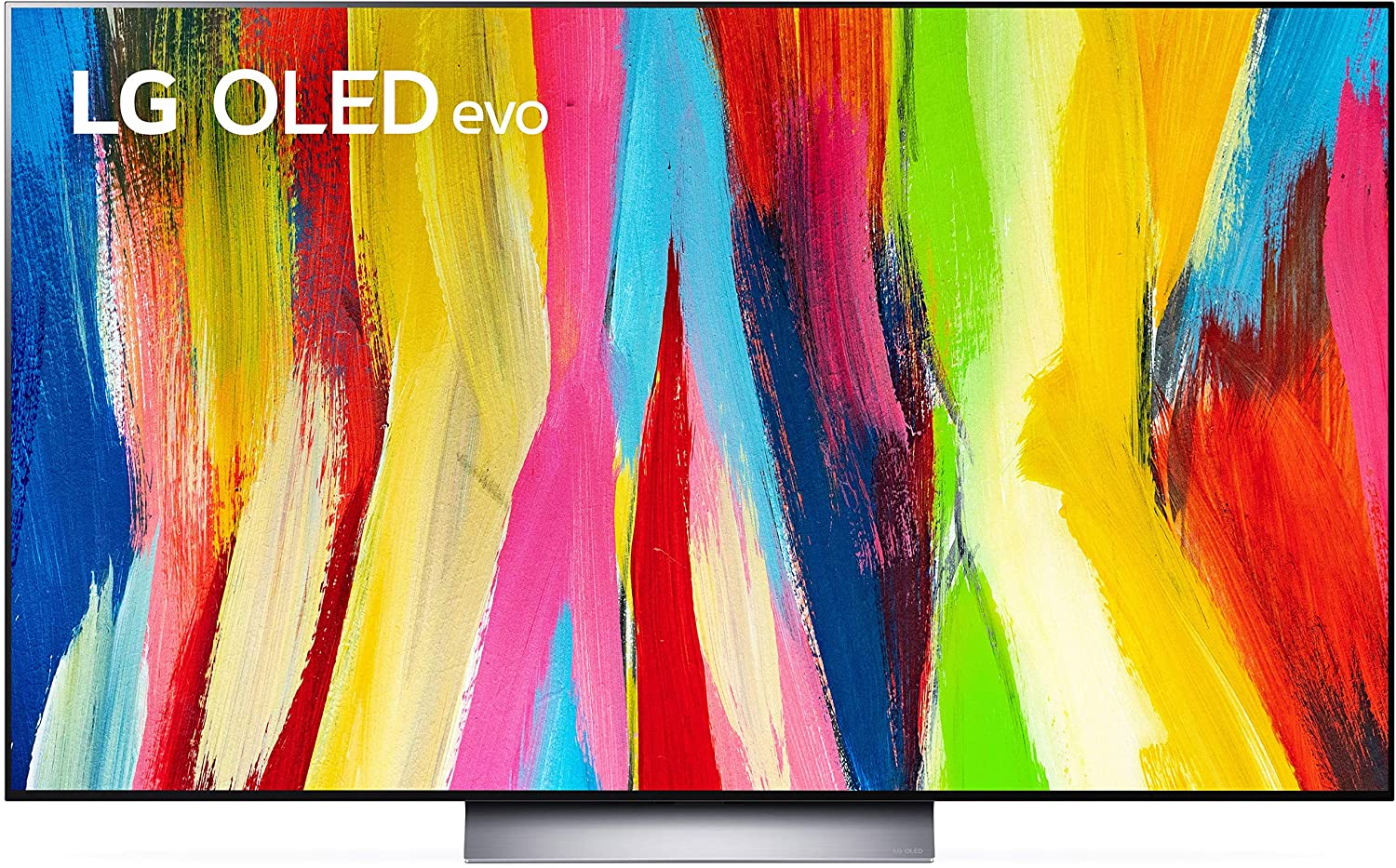
LG C2 Evo OLED
Another great LG OLED
Frequently Asked Questions
What size 4K TV should I buy?
The answer to that depends on many factors, including your stylistic preferences, the size of the room, and how far away you’ll be sitting. Take a look at our guide to choosing the perfect TV size for you.
What should you be aware of when it comes to viewing angles for your TV?
If you want to relish your TV from a variety of viewing positions, you’ll need a TV with wide viewing angles. Of the two main LCD panel types (IPS and VA), IPS panels offer the greatest viewing angles. However, this can sometimes come at the cost of worse contrast. OLED TVs offer both excellent contrast and viewing angles, compared to their QLED counterparts, which are best watched from the center position.
What is QLED?
QLED stands for quantum dot LED TV, and it uses a layer of tiny particles to improve an LED TV’s color accuracy without diminishing brightness. QLED TVs still don’t deliver the perfect blacks of OLED TVs, but the newest ones come very, very close. Because QLED TVs often have powerful backlights that use hundred (or in the case of mini-LED, thousands) of LEDs, they can get brighter than the brightest OLED TVs.
You may want to check out our article that covers QLED vs. OLED TV: What’s the difference, and why does it matter?
What is OLED?
OLED stands for organic light-emitting diode, and these TVs are notable for their ability to produce perfect blacks and what is sometimes referred to as “infinite” contrast. These TVs accomplish this through their ability to completely shut down the light they emit on a pixel-by-pixel basis, something QLED TVs can’t do because they rely on a separate backlight to create brightness. You can block a lot of the light produced by a backlight, but not 100%.
What is the best Roku TV?
These are the best Roku TVs. Roku has also started manufacturing its own “Roku-made” TVs, which are on store shelves now.
How well does 4K TV upscaling work?
That depends on the TV, but as a general govern of thumb, the better (and more expensive) the TV, the better the upscaling.
Are budget 4K TVs any good?
Almost all new TVs are 4K, so there are plenty of fantastic options to select from at the lower end of the pricing scale. Don’t expect a standard LED TV to rival an OLED or QLED, though — set your expectations accordingly. We suggest looking for a quantum dot LED TV (QLED) model, as these will offer the best picture quality at lower prices.
Can a 4K TV work well as a PC monitor?
Yes, so long as your computer has an HDMI output. Adapters can be used for other output types but frequently do not pass along audio.
Do 4K TVs usually have Alexa, Google Assistant, or Siri?
Most modern TVs can be paired with Amazon Alexa and Google Assistant through either an Amazon Echo, Fire TV, or Google Home device. Some televisions even have them built-in, eliminating the need for a smart speaker.
Right now, there are no TVs that have Siri built-in. Those that uphold AirPlay 2 and HomeKit, however, can be controlled using Siri on an iOS device, such as an iPad, iPhone, HomePod, or HomePod Mini, as well as a Mac.
Do 4K TVs have problems with burn-in?
OLED TVs are the only type of 4K TVs that have the potential to suffer from burn-in, though it’s incredibly uncommon. Unless you appreciate to leave the same news channel playing for eight hours a day, seven days a week for weeks on end, you probably don’t need to worry about it.
How we assess TVs
At Digital Trends, we aim for our product reviews to furnish readers with insight into both a product’s technical performance and its usability. To that end, we go beyond specs and measurements by placing emphasis on the user encounter. For televisions, that means taking a close look at all the little touch points that, taken together, make the difference between a TV you can live with and a TV you’ll love. Here’s how we assess TVs to furnish readers with valuable, real-world insight before making that important purchasing decision.
Testing environment
The bulk of our testing takes place in a completely dark room. This allows us to adjust picture settings and assess a TV without concern for ambient light and the effects it has when reflected off a TV’s screen. Later, we’ll proceed the TV to a room made bright by lots of exposure to natural sunlight through multiple windows. This gives us the opportunity to see how well the TV will perform in a real-world scenario, as many TVs are placed in common rooms where light is not so easily controlled.
Deboxing and placement
As we pull a TV from its box, we take note of how well it is packaged for transit. This is an important consideration for those who may order their TV online and need to know that their product will achieve in tip-top shape. We also pay attention to how easy it is (or isn’t) to eradicate the TV from its packaging and attach it to its stand. Once the TV is in place, we take a look at the TV’s stability – nothing’s worse than a TV that wobbles every time you get up for popcorn or that’s one bump away from taking a dive to the floor.
Build quality and visual appeal
We take a look at several factors involved with the TV’s build quality and visual appeal. We check the back panel to see if it is strong or flimsy, get a feel for the material that the bezel is made of and gauge the strength of the display panel. We look at the build quality of the base and evaluate how well it aesthetically matches up with the TV. We then take a step back and scrutinize how reflective the display panel is in bright conditions and consider the display’s overall visual appeal as we visualize how it will blend with various types of home decor. If a display’s bezel is littered with marketing stickers, we expect them to be easy to eradicate.
Setup and first impressions
Making connections to a TV is generally a straightforward procedure. If it is not, we’ll certainly cite it. Since many of today’s TVs offer access to several online media services, we take this time to enter our account information and passwords. Those TVs that make the data entry process easier get bonus points since the status quo is for the process to be a pain in the neck. We’ll also check to make sure our LAN connection is functioning and that the TV has successfully connected to our network and the Internet.
With data entry out of the way, we begin to feed the TV with 1080p content that we are very familiar with. We generally use the same six or seven scenes that we’ve seen countless times on a myriad of televisions over the past few years. We’ll cycle through the TV’s different picture pre-sets and note our impressions of the images we see from the TV straight out of the box. This information will be compared with the results we get after we calibrate the TV.
Calibration
We primarily use the Spears and Munsil High Definition Benchmark Blu-ray disc to calibrate the TVs we assess. This particular disc offers an excellent combination of assess patterns for calibration and video sequences for gauging the TVs performance against benchmark standards. Occasionally, we will break out other assess discs to cross-scrutinize our settings.
To start with, we disable all image-correction processors implemented by the manufacturer in order to level the playing field. We may later fold these processors back in. If we note that any particular image processor provides significant improvement to the image, we’ll be sure to cite it in our review.
Digital Trends uses the same calibration tools and benchmarks available to consumers; you won’t find us using lab equipment to take lofty measurements such as how close a set’s color temperature gets to 6,500 Kelvin. Why? While this sort of information can be very valuable to some, we feel our readers are more interested in knowing how easily the display can be calibrated using commonly available tools and resources.
Once we have calibrated the television, we look at how much adjustment to the TV’s default settings were needed in order to achieve desired standards of performance. It is based on this user-oriented standard and our encounter calibrating similarly classed televisions that we score some of the more objective points of a TVs performance.
Picture quality
With the TV calibrated, we re-visit the same video clips we used prior to calibration and advance scrutinize the image by making subjective observations of factors such as motion blur, motion judder, visible artifacts, uniformity of brightness, black levels and color saturation. Once the display is moved to our “bright room”, we look at how reflective the screen is and see how the TV’s black levels and contrast hold up under the more challenging light conditions. We’ll often make adjustments to the TV’s settings to unveil how well the set maintains its color when backlight, brightness and contrast levels must be adjusted. If the TV has a sensor system designed to make automatic adjustments based on ambient light levels, we’ll assess it at this time and draw subjective comparisons to similar systems we’ve tested in the past.
If the TV is 3D capable, we’ll assess its 3D performance and rank it according to other active or passive 3D systems we’ve tested previously. We may look at 2D to 3D conversion, but tend not to weigh it heavily in our scoring since we consider this to be a novelty feature.
Menu navigation
All the built in features and functionality in the world don’t amount to much if it is difficult to get at them. Today’s TV’s pack far more than simple picture adjustments into their user menu. As the list of functions grows, the need for a well-organized menu system with a speedy response becomes increasingly crucial. Our TV testing takes menu navigation into consideration as part of a larger ease-of-use evaluation. We expect the the menus and options to be clear, intuitive and quick to reply to user input.
Internet and network media access
Many TVs offer access to the same streaming music and video services, but the design of the apps for them makes all the difference in whether we use them or not. We assess apps for services appreciate Netflix, YouTube and Pandora and differentiate them to the apps installed in competing televisions, as well as those found in other Internet media sources, such as Blu-ray disc players and game consoles. We expect content to be easy to access and easily searchable.
We also assess the network media interface provided in DLNA certified televisions. The promise of access to pictures, video and music on a home network is appealing, but, again, only practical if the content is easy to access and quick to load.
Remote control
The remote control is a critical component in a TV’s ease of use. We check to see if the remote sits comfortably in the hand, and whether or not it is backlit. We expect buttons to be well laid out and a big enough to press without unintentionally pressing others. We appreciate to see that frequently used functions are represented and that “hot-keys” are made available for some of the media apps. Off-axis function is also tested, as not everyone sits directly in front of their TV.
Audio quality
While we usually suggest that a display be paired with some sort of external audio system such as a soundbar or home theater system, we grasp that not everyone has plans for this and, even if they do, that the TV’s speakers will probably be used for everyday watching. This is why we furnish information on at TV’s built-in audio performance. We’ve found that many manufacturers treat a TV’s built-in audio as an afterthought, and if the TV is going to sound terrible without external audio, you need to know it before you buy.
Overview
Once our testing is complete, we take into consideration a television’s overall performance, its price point, and the competition it faces with similarly priced and featured TVs. Over the past few years, we’ve seen performance boost as price decreases, thus redefining the notion of value in high-definition televisions. We also factor in the changing curve in technology as once-exclusive and expensive features appreciate local dimming make their way down to mid-level and sometimes even entry-level models. This changing landscape puts pressure on models that demand a premium price, so scoring for premium models will tend to be tougher.
We want readers to walk away from our TV reviews with a solid idea of what it would be appreciate to own any particular TV model, and whether the TV in question might be a good fit in their homes based on our published observations.
As always, we value reader feedback and will take comments,, requests and questions into consideration as we refine our testing processes to ponder the needs of our readers.
Glossary of terms
Here’s a rundown of some of the most common terms associated with today’s TV technology.
4K Ultra HD
This refers to a display resolution that is four times that of 1080p HD. A 4K Ultra HD TV’s pixel resolution is a 3,840 x 2,160 grid in a 16:9 aspect ratio, resulting in nearly 8.3 million pixels. This boost in density adds striking detail and realism to an image and allows larger screens to be viewed from closer distances without individual pixels becoming visible.
High dynamic range (HDR)
High dynamic range is probably most familiar to people through the HDR mode on their digital cameras. It’s designed to deliver a picture that has greater details in the shadows and highlights, plus a wider range of colors. HDR in televisions pursues the same goal. The color palette is wider, blacks are deeper, and whites are brighter.
Presently, there are two major HDR formats: HDR10 and Dolby Vision, with a third — HDR10+ — beginning to show up on new models, particularly those from Samsung. The first is the HDR standard, but Dolby Vision offers a premium encounter. Consider a TV that supports both. HLG (hybrid log gamma) is another recent addition to the HDR collection, which supports over-the-air (OTA) broadcast content with HDR.
Full-array local dimming (FALD)
This refers to an LED TV’s backlighting system. A FALD display contains an array of LEDs spread out in a grid behind an LCD panel, rather than just at the edges of the TV. This LED array is broken up into zones that can be dimmed when necessary to accomplish better black levels. Another benefit is more uniform brightness across the screen.
Wide color gamut (WCG)
These are the expanded color reproduction abilities of a 4K Ultra HD TV, which are closer than ever to what we see in a digital cinema. By approaching (or sometimes exceeding) the Digital Cinema Initiative’s (DCI) P3 color specification, a 4K UHD TV can produce billions of more colors than a 1080p HD TV.
Quantum dots
A layer of film loaded with tiny nanocrystal semiconductors is placed in a TV’s display panel to help produce a more accurate array of colors. Quantum dots work by producing a purer form of white light from a TV’s backlighting system, which helps the TV’s color filter perform more accurately.
Phosphor-coated LED
An alternative to Quantum Dots, phosphor-coated LEDs have a chemical coating to alter the light’s output. When used in a TV, this results in a purer backlight that’s more easily manipulated by a TV’s color filter, resulting in a wide color gamut and increased color accuracy.
HDMI 2.1
The latest version of the HDMI spec. It offers new enhancements for video games appreciate variable refresh rate (VRR) and automatic low-latency mode (ALLM) and the ability to pass 4K signals to the TV at up to 120Hz, for ultra-smooth motion. HDMI 2.1 is a requirement for 8K video sources appreciate the PlayStation 5 and Xbox Series X. For most non-gamers, HDMI 2.1 is a nice way to future-proof yourself but it’s nowhere near a necessity yet.
HDCP 2.3
The latest version of the High-Bandwidth Digital Content Protection technology, which provides copy prevention specifically of 4K Ultra HD and 8K content. Any source device that requires HDCP 2.3 will necessitate a TV with an HDCP 2.3-compliant HDMI port for a compatible connection.
HEVC (H.265)
Stands for “High-Efficiency Video Coding.” A compression technology developed to make large 4K UHD video files smaller and, therefore, easier to stream over broadband Internet connections. HEVC is said to double the data compression ratio over H.264, the predominant encoding technology used today for 1080p videos while retaining the same video quality. A smart TV or streaming set-top box must be able to decode HEVC to playback 4K Ultra HD video from sites appreciate Netflix and Amazon Prime Video.
VP9
An alternative to HEVC developed by Google and used predominantly for encoding 4K Ultra HD YouTube videos. For a smart TV or streaming set-top box to play 4K Ultra HD YouTube videos, it must be able to decode VP9 videos.
Editors’ Recommendations

